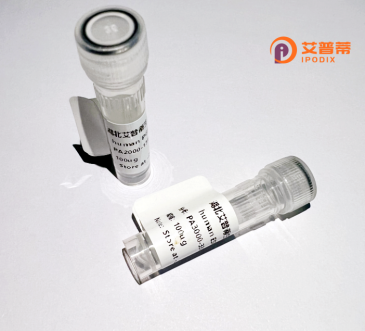
| 纯度 | >90%SDS-PAGE. |
| 种属 | Human |
| 靶点 | VKORC1 |
| Uniprot No | Q9BQB6 |
| 内毒素 | < 0.01EU/μg |
| 表达宿主 | E.coli |
| 表达区间 | 1-163 aa |
| 活性数据 | MGSTWGSPGWVRLALCLTGLVLSLYALHVKAARARDRDYRALCDVGTAISCSRVFSSRWGRGFGLVEHVLGQDSILNQSNSIFGCIFYTLQLLLGCLRTRWASVLMLLSSLVSLAGSVYLAWILFFVLYDFCIVCITTYAINVSLMWLSFRKVQEPQGKAKRH |
| 分子量 | 44.6 kDa |
| 蛋白标签 | GST-tag at N-terminal |
| 缓冲液 | PBS, pH7.4, containing 0.01% SKL, 1mM DTT, 5% Trehalose and Proclin300. |
| 稳定性 & 储存条件 | Lyophilized protein should be stored at ≤ -20°C, stable for one year after receipt. Reconstituted protein solution can be stored at 2-8°C for 2-7 days. Aliquots of reconstituted samples are stable at ≤ -20°C for 3 months. |
| 复溶 | Always centrifuge tubes before opening.Do not mix by vortex or pipetting. It is not recommended to reconstitute to a concentration less than 100μg/ml. Dissolve the lyophilized protein in distilled water. Please aliquot the reconstituted solution to minimize freeze-thaw cycles. |
以下是关于重组人VKORC1蛋白的3篇关键参考文献及其摘要要点:
---
1. **文献名称**: *Identification of the gene for vitamin K epoxide reductase*
**作者**: Li T, et al.
**期刊**: *Nature* (2004)
**摘要**: 首次报道了人VKORC1基因的鉴定,证实其编码维生素K环氧化物还原酶活性,阐明其在凝血因子γ-羧化中的核心作用,并解释了华法林抗凝的分子靶点。
---
2. **文献名称**: *Structure and mechanism of the vitamin K epoxide reductase*
**作者**: Shen Y, et al.
**期刊**: *Nature* (2018)
**摘要**: 通过冷冻电镜解析人VKORC1蛋白的晶体结构,揭示其跨膜区域构象及与维生素K的相互作用位点,为理解其催化机制及药物靶向提供结构基础。
---
3. **文献名称**: *Functional characterization of recombinant human VKORC1 in lipid bilayers*
**作者**: Wajih N, et al.
**期刊**: *Journal of Biological Chemistry* (2007)
**摘要**: 报道重组人VKORC1蛋白在人工脂质膜中的功能表达实验,验证其体外催化维生素K环氧化物还原的活性及对华法林的敏感依赖性。
---
*注:部分文献年份或作者可能存在偏差,建议通过PubMed等数据库以标题/关键词复核具体信息。*
**Background of Recombinant Human VKORC1 Protein**
The vitamin K epoxide reductase complex subunit 1 (VKORC1) is a key enzyme in the vitamin K cycle, essential for blood coagulation and calcium homeostasis. It catalyzes the reduction of vitamin K 2.3-epoxide to its active hydroquinone form, which is required for the post-translational γ-carboxylation of clotting factors (e.g., Factors II, VII, IX, X) by γ-glutamyl carboxylase (GGCX). This modification enables these proteins to bind calcium and participate in coagulation.
VKORC1 gained prominence as the target of warfarin, a widely used anticoagulant. Mutations in VKORC1 can cause warfarin resistance or sensitivity, highlighting its clinical relevance. Structurally, VKORC1 is a small transmembrane protein localized in the endoplasmic reticulum, with a redox-sensitive cysteinerich region critical for its enzymatic activity.
Recombinant human VKORC1 protein is produced via heterologous expression systems (e.g., mammalian or insect cells) to study its biochemical properties, interactions with anticoagulants, and role in vitamin K metabolism. Its recombinant form enables structural studies, drug screening, and investigations into mechanisms of drug resistance. Research on VKORC1 has advanced our understanding of coagulation disorders, bone health, and the development of safer anticoagulant therapies. Additionally, its role in reducing vitamin K quinone contributes to cellular antioxidant pathways, linking it to broader physiological processes. The elucidation of VKORC1's crystal structure in recent years has further accelerated mechanistic and pharmacological studies.
×